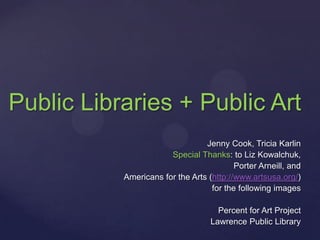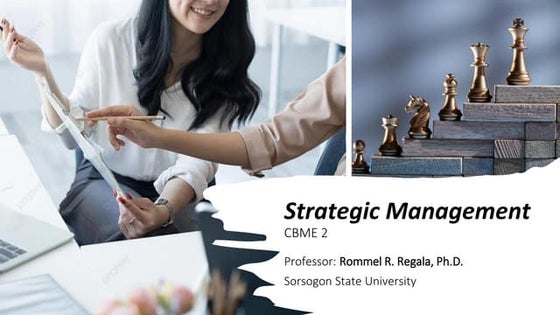Public Libraries + Public Art
- 1. Public Libraries + Public Art Jenny Cook, Tricia Karlin Special Thanks: to Liz Kowalchuk, Porter Arneill, and Americans for the Arts (http://www.artsusa.org/) for the following images Percent for Art Project Lawrence Public Library
- 2. Laser Lawn (2007) Dan Corson Lasers, aluminum, computer control system, sensors. Huizenga Plaza, Ft Lauderdale, FL
- 3. Laser Lawn
- 4. Solar Time Plane (installed in 2005) Dale Eldred Metal Broward County Main Library, Broward County, FL
- 5. Who am I Seyed Alavi 6 composite portrait images temporarily displayed in light boxes along the length of Market Street, San Francisco
- 6. Who am I
- 7. After Image (2007) Linda Beaumont Washington State Arts Commission
- 8. After Image
- 9. Seagrass Barbara Grygutis Fabricated Aluminum, Lighting 30’H x 10’W x 6’D Ocean boulevard Median Sculptures, Long Beach, California
- 10. Harmonic Convergence (2011) Christopher Janney Commissioned by Miami International Airport, Miami Dade County, Art in Public Places
- 12. Bay Area Bird Encounters (2011) Walter Kitundu Commissioned by San Francisco Arts Commission, San Francisco International Airport
- 13. Bay Area Bird Encounters
- 14. West Hollywood Library Murals (2011) Shepard Fairey, Kenny Scharf, RETNA (Marquis Lewis) Paint West Hollywood, CA
- 15. West Hollywood Library Murals
- 16. Flying carpet (2005) Seyed Alavi Wool and Nylon Carpet; 18.5’W x 150’L Sacramento International Airport
- 17. Flying carpet
- 18. Souls of Trees (2007) Heather Carter Bent pine Spicewood Springs Branch Library, Austin, TX
- 19. Parabiosis VII (2008) Kendell Buster Powder coated steel, greenhouse shade cloth Agave Branch Library, Phoenix, AZ
- 20. Leap (2011) Lawrence Argent Aluminum, steel, crushed glass, urethane. Case: Chinese green granite, bronze Commissioned by Sacramento Metropolitan Arts Commission
- 21. Leap
- 22. Heart and Mind (2011) Ralph Helmick Commissioned by Oregon Arts Commission
- 23. Core Sample, I (Projector) and Core Sample, II (Fountain) and Foundations (2011) Chris Sauter Commissioned by City of San Antonio Office of Cultural Affairs
- 24. MLK Jr. Memorial Barbara Grygutis Granite / Handmade ceramic tile / Sod Columbia, MO
- 25. Around Town Larry Kirkland Bench: carved and engraved white Carrara marble. Tires: African black granite Chapel Hill, North Carolina
- 26. Around Town
Editor's Notes
- #3: Artist’s statement: “Lasers moving through the grass allow us to experience in a new way something that is ubiquitous in the American Landscape- Lawn. Turf or sod is the largest irrigated crop in the United States.. It is everywhere. Illuminating the lawn with coherent radiation, allows us to re-see with new eyes what is normal and all around us. “
- #4: “Moving light simulates (and stimulates) the growth of the lawn, the flooding of the fields, the sparkle of the dew on the grass. The kinetic patterns on the lawn animate the grass for people to explore and play with the light.”
- #5: şÝşÝߣ courtesy of Liz KowalchukThe late Dale Eldred designed this sculpture that refracts sunlight during day hours and artificial illumination at night. With the refraction, there is a constant shifting spectrum of colors.Artist statement: "What is important in this work is not in the structure itself, not in its object nature, but in the phenomena which take place on its surface. The sculpture is a very carefully constructed receiver, designed to intercept and manipulate light - to expose its properties and its components - and to allow this light, in its daily passage across all our surfaces, to prod us a little in our geocentristillusion“
- #6: Artist’s statement:Who Am I?” is a series of six composite portrait images each created by layering photographs of individuals whom I encountered along Market Street in San Francisco. These images are meant to reflect the diversity of people who live, work and play along Market, while expressing the similarities that also exist between us all.
- #7: With this piece I sought to explore the notion of identity. What is our personality? Is our character created out of the collage of people that we have come into contact with throughout our lives? Is our personality similar to a patchwork quilt, a bit from here and a bit from there? Or is there perhaps a more fundamental aspect which identifies each individual? These images were reproduced as digital prints which were temporarily displayed in light boxes along the length of Market Street. Next slide
- #8: This installation includes two light boxes with images of treesfrom the Pacific Northwest forest. They frame the view out to the forest, but soon, the view will be blocked by a new building.
- #9: Artist’s statement: The magnificent forest that once grew in the Pacific Northwest touches the edge of our memories with an after image, both retinal and physical. The beauty of growth, the nature of time, and a sense of awe are held in a single tree.
- #10: This work was inspired by the motion of sea grass underwater as it ebbs and flows in the current. It is composed of a series of sculptural pieces infused with LED light. It creates a continuous shimmering effect. Next slide
- #11: şÝşÝߣ from Americans for the ArtsBudget: $1,000,000Harmonic Convergence is one of Artist Christopher Janney's "Urban Musical Instruments." This work uses a diagonal pattern of colored glass together with an interactive sound-score integrated into the terminal.
- #12: şÝşÝߣ from Americans for the ArtsAs people move through the space, they prompt the playing of natural sounds from the South Florida environment. The sounds range from tropical birds and distant thunder storms to sounds of the Everglades As sunlight moves throughout the day, the colored glass changes it shadows on the floor, allowing people to immerse themselves in what Janney calls "an abstraction of South Florida in color and sound.“
- #13: şÝşÝߣ from Americans for the ArtsBudget: $50,602 Artist Walter Kitundu created a group of interactive artworks that were designed to offer travelers of all ages a playful oasis. Kitundu created two benches shaped like bird wings that double as musical instruments. Serving as the backdrop for these musical benches, is a mural made of inlaid wood featuring local birds.The birds are photographs that the artist took in San Francisco & they are printed on wood & also inlaid. Next slide.
- #14: şÝşÝߣ from Americans for the ArtsThe focal point of the mural is a large bird whose wings, like the benches, are like a xylophone and can be played with rubber mallets. Each of the musical components of his installation are linked to a specific bird. When played left to right, a portion of the bird’s song is heard.The instruments can also be played freely, and they are tuned so that they can be played together
- #15: şÝşÝߣ from Americans for the ArtsBudget: $56,000Arising from MOCA’s landmark exhibit, “Art in the Streets,” the three murals are the fruits of an innovative collaboration between MOCA and the City of West Hollywood with principal funding from Cadillac and Vanity Fair. MOCA Director Jeffrey Deitch was intrigued by the three large blank white walls on the exterior of the new 5-story parking structure that would serve the new West Hollywood Library scheduled to open October 1, 2011. With a satellite gallery space at the Pacific Design Center and a desire to better connect MOCA’s gallery with the City of West Hollywood, Deitch felt the large blank walls would be an ideal canvas for three of the street artists featured prominently in the “Art in the Streets” exhibit – Shepard Fairey, Marquis Lewis (RETNA) and Kenny Scharf. The three artists were equally intrigued and challenged with the opportunity to create works on such a large scale, representing one of the largest, if no the largest canvas each artist had been able to paint. Interestingly, while the original design of the building called for blank white walls and some members of the community were concerned about “graffiti” artists painting on the beautiful new library, no one now can imagine these walls any other way. The City has gone a bit “mural” crazy, with many businesses now pursuing permits to place murals on blank walls of their businesses and the City of West Hollywood looking to incorporate more murals into other public spaces. The works are a testimony to the artists tuning into the opportunity and the community. Each artist considered his wall and from where it would be seen. Shepard provides an entryway into the public garage for autos and pedestrians and has found a way with his “Peace Elephant” to celebrate the City which was one of the first in the nation to officially protest the war in Iraq. Scharf’s playful figures face the park directly and overlook a children’s playground area. RETNA’s work faces the Business Improvement District known as the Avenues of Art, Fashion and Design and in his signature graphic style portrays a quote from Salman Rushdie about the power of literature – an apt quote as a reminder of the important role libraries and access to ideas plays in a democratic society.
- #16: şÝşÝߣ from Americans for the ArtsBudget: $56,000Arising from MOCA’s landmark exhibit, “Art in the Streets,” the three murals are the fruits of an innovative collaboration between MOCA and the City of West Hollywood with principal funding from Cadillac and Vanity Fair. MOCA Director Jeffrey Deitch was intrigued by the three large blank white walls on the exterior of the new 5-story parking structure that would serve the new West Hollywood Library scheduled to open October 1, 2011. With a satellite gallery space at the Pacific Design Center and a desire to better connect MOCA’s gallery with the City of West Hollywood, Deitch felt the large blank walls would be an ideal canvas for three of the street artists featured prominently in the “Art in the Streets” exhibit – Shepard Fairey, Marquis Lewis (RETNA) and Kenny Scharf. The three artists were equally intrigued and challenged with the opportunity to create works on such a large scale, representing one of the largest, if no the largest canvas each artist had been able to paint. Interestingly, while the original design of the building called for blank white walls and some members of the community were concerned about “graffiti” artists painting on the beautiful new library, no one now can imagine these walls any other way. The City has gone a bit “mural” crazy, with many businesses now pursuing permits to place murals on blank walls of their businesses and the City of West Hollywood looking to incorporate more murals into other public spaces. The works are a testimony to the artists tuning into the opportunity and the community. Each artist considered his wall and from where it would be seen. Shepard provides an entryway into the public garage for autos and pedestrians and has found a way with his “Peace Elephant” to celebrate the City which was one of the first in the nation to officially protest the war in Iraq. Scharf’s playful figures face the park directly and overlook a children’s playground area. RETNA’s work faces the Business Improvement District known as the Avenues of Art, Fashion and Design and in his signature graphic style portrays a quote from Salman Rushdie about the power of literature – an apt quote as a reminder of the important role libraries and access to ideas plays in a democratic society.
- #17: A Site Specific Public Art Project for the Sacramento International Airport From Artist’s web site: This project consists of an aerial view of the Sacramento River that is woven into a carpet for the floor of a pedestrian bridge connecting the terminal to the parking garage. This image represents approximately 50 miles of the Sacramento River starting just outside of Colusa, California and ending about 6 miles south of Chico. In addition to recalling the experience of flight and flying, this piece, by depicting the larger geographical area, also helps to reinforce a sense of belonging and/or connection for the traveler. In this way, the carpet can also be read and experienced as a “welcome mat” for visitors arriving in Sacramento. The siting of this piece on a bridge also helps to highlight a few other conceptual aspects of the work. A bridge is a connection between two destinations; it is not a destination in and of itself; it is neither here, nor there. In this way it is similar to an airplane, or a river connecting one place to another; here to there; a moment of flight frozen in mid air; a flowing river that takes us along with its current to another destination. In this way, the piece also creates a koanic relationship between a river and a bridge, since their ordinary position have been turned around, and it is now the river that is on/above the bridge.By working with carpeting in this context, I have been able to transform something quite ordinary into an extra-ordinary aesthetic experience. This apparently simple gesture, integrates multiple layers of harmonious meanings and references, in order to stimulate a conceptual dialog. Ultimately, however it was my intention with this project to present a fun and humorous situation for laughter and play, where travelers will feel rejuvenated and reminded of the magic of flight. With Special Thanks to Charles Nelson-Cal State Chico and Ulster Carpet
- #19: şÝşÝߣ courtesy of Liz KowalchukArtist Heather Carter collaborated with the project architects as she developed artwork for the new reading room of the Library. Her proposed design for Souls of the Trees, featured eleven bent pine sculptural forms that would be installed above the window wall. In the words of the artist, "Trees sustain life on earth, creating much of the oxygen animals depend on, and food and habitat for creatures of all kinds. They conserve soil moisture, prevent erosion and facilitate rain in otherwise arid regions. Trees also nourish us aesthetically, and in their omnipresence on virtually every continent, signify the fecundity and resilience of life on earth." The artwork symbolizes and honors this legacy in its creation as a carbon-neutral piece. Carter calculated the amount of carbon that was emitted from the creation of this artwork, and planted three trees outside the library to absorb this carbon dioxide. In doing this, the artist hopes that many will consider the environmental impact of their lifestyle and plant trees.
- #20: şÝşÝߣ courtesy of Liz KowalchukThe art consists of a free-hanging sculpture of seven connected amorphous forms made of powder coated steel framing covered in greenhouse shade cloth. The artist describes the piece as being like an organism that has filled with a deep breath or a cluster of dirigibles in suspended animation. The piece provides a soft, seemingly billowing form above the information desk in the Will Bruder-designed Agave Branch Library. This project was completed in 2008.
- #21: şÝşÝߣ from Americans for the ArtsBudget: $840,000 A unique and complex computer program was designed by Kreysler and Associates to enable the artwork to be fabricated in a non-combustible material (required by the airport) and designed so that welds, rivets and bolts were invisible. The artwork has two “skins” and is comprised of 2,930 CNC cut aluminum triangles – all a different size and installed at a different angle. This highly complex design also had to be built and transported in 14 sections so that it would fit through a small entrance after the building was 95% completed.
- #22: şÝşÝߣ from Americans for the Arts
- #23: şÝşÝߣ from Americans for the ArtsBudget: $250,000Oregon Tech's Dow Hall is the campus science building. The perceptual phenomenon employed by the sculpture - anamorphosis - embodies qualities of inquiry, serendipity and relativity. As such, Heart and Mind is an especially appropriate esthetic metaphor for the spirit of investigation and discovery at the school.
- #24: şÝşÝߣ from Americans for the ArtsBudget: $60,250San Antonio's new Mission Branch Library is located on a historic site adjacent to Mission San Jose, the Mission Drive-In Theatre and new Mission Reach river improvements projects on the city's Southside. Commissioned by the City of San Antonio through Public Art Antonio (PASA) as part of the City's 2007 - 2012 Bond Program, San Antonio native Chris Sauter created a series of artworks for the site that is based on the concepts of history, exploration and discovery. The artworks take on the look and language of archaeology and geology as primary approaches. Responding to the rich history of the site and knowledge that the library is strategically sited to serve an important community-building function, Sauter's mixed-media mural for the library's interior metaphorically illustrates the deep stretch of geological history that lies beneath the grounds of the new library. The mural depicts the new library and neighboring Mission San Jose atop a vast array of layers comprised of images, textures and text that represent historical occurrences, both recent and prehistoric. "I wanted to create an experience that generates not only a desire to enter and explore the knowledge found on the shelves of the library, but also an active engagement with history. Engaging people in their history helps foster a sense of community," says Sauter.Two outdoor sculptures follow through with the artist's notion of depicting "deep time." The two cylindrical-shaped sculptures look like geological "core samples" that have been excavated from the grounds of the library. The freestanding sculptures are comprised of multiple layers of highly textured, colored concrete that were cast in place. They are encrusted with hand-crafted "fossils" and "artifacts" embedded onto the surface."Core sample: Projector" is positioned near the entrance of the library and is equipped with a cast-metal, vintage movie projector that projects the library's name onto the building's façade. "Core Sample: Fountain" is located within the library's courtyard. One of its layers seeps water that runs down the sculpture into what looks like the hole from which it came. Planted at the top of the hollowed-out structure is a Mountain Laurel, a native tree revered by the Texas Mission Indians. As site-responsive public art, these works created by Sauter evoke the actual and the mythological layers of rich history that lie beneath the library.
- #25: MLK Jr. Memorial 1993 9'H x 50'W x 50'DColumbia, MOGranite / Handmade ceramic tile / SodThe amphitheater is designed for public events and private reflection. Quotes by Dr. King on the pillars punctuate the top level of the amphitheater. A spiral walkway of thirty-nine and one third stones represents the years of Dr. King's life. A quote from Dr. King's last speech, "I See the Promised Land," is etched into a smaller stone at the entrance to the Memorial’s spiral path. Collaborator: Dr. Linda Bolton
- #26: Around TownChapel Hill, North CarolinaAround Town is an installation near the entrance to the Chapel Hill Transit complex, an administration and maintenance center for the buses that serve the area.The artwork consists of a 40-foot-long Carrara marble bench. Midway along the bench, the back shifts sides, allowing those seated the option of one view or another—like passengers on a bus. Large black granite forms at either end of the bench recall enormous bus tires.The seat back is a sculpted, undulating elevation that references the region’s rolling topography. Engraved into the bench are images from the area, such as local architecture, wildlife, and sports references.










































































